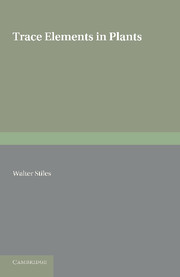Book contents
- Frontmatter
- Dedication
- Contents
- Preface
- Preface, to the First Edition
- List of Plates
- List of Abbreviations
- I HISTOBICAL INTRODUCTION
- II METHODS OF INVESTIGATING MICRO-NUTRIENT PROBLEMS
- III TRACE-ELEMENT DEFICIENCY DISEASES OF PLANTS
- IV THE EFFECTS ON PLANTS OF TRACE-ELEMENT EXCESS
- V FACTORS INFLUENCING THE ABSORPTION OF TRACE ELEMENTS AND THEIR EFFECTS ON PLANTS
- VI THE FUNCTIONS OF TRACE ELEMENTS IN PLANTS
- VII TRACE ELEMENTS IN PLANTS IN RELATION TO SOME DISEASES OF GRAZING ANIMALS
- VIII CONCLUDING REMARKS
- List of Literature
- Index
VIII - CONCLUDING REMARKS
Published online by Cambridge University Press: 05 June 2016
- Frontmatter
- Dedication
- Contents
- Preface
- Preface, to the First Edition
- List of Plates
- List of Abbreviations
- I HISTOBICAL INTRODUCTION
- II METHODS OF INVESTIGATING MICRO-NUTRIENT PROBLEMS
- III TRACE-ELEMENT DEFICIENCY DISEASES OF PLANTS
- IV THE EFFECTS ON PLANTS OF TRACE-ELEMENT EXCESS
- V FACTORS INFLUENCING THE ABSORPTION OF TRACE ELEMENTS AND THEIR EFFECTS ON PLANTS
- VI THE FUNCTIONS OF TRACE ELEMENTS IN PLANTS
- VII TRACE ELEMENTS IN PLANTS IN RELATION TO SOME DISEASES OF GRAZING ANIMALS
- VIII CONCLUDING REMARKS
- List of Literature
- Index
Summary
IT will be clear from the preceding review of the present position of our knowledge of trace elements in plants that these elements present the biologist with two sets of problems, the one pathological, the other physiological. The pathologist is concerned with the abnormal conditions resulting in plants from deficiency or excess of the various trace elements, and of the means by which the deficiency or excess can be removed. The problems of the physiologist are more subtle, for it is his business to discover the functions in the life of the organism of these various elements which are present in only minute amounts. The two sets of problems are of course interdependent, for the work of the pathologist in discovering the effects of deficiency greatly aids the physiologist, while knowledge of the part played by the trace elements in the life of the organism must necessarily help the pathologist in the diagnosis and treatment of deficiency diseases. But on the whole, knowledge of the pathology of trace elements is much more advanced than our knowledge of their physiological functions. A considerable number of well-recognized and defined plant diseases are now correctly attributed to various trace-element deficiencies, and means of controlling these diseases have been determined with considerable precision. Future work on the pathological side may extend the number of such known deficiency diseases. In addition to such work it would appear that two lines of research in the field of pathology would well repay attention. The first of these is the development of rapid means of early diagnosis. The usual method of observing deficiency symptoms, employed with outstanding success by Wallace, is naturally only applicable after visible external symptoms have developed. The injection methods elaborated by Roach appear to be particularly useful for trees, but although certainly usable for annual crops, and affording a means of early diagnosis, require some degree of technical skill for their employment with small herbaceous plants.
- Type
- Chapter
- Information
- Trace Elements in Plants , pp. 195 - 198Publisher: Cambridge University PressPrint publication year: 2013



